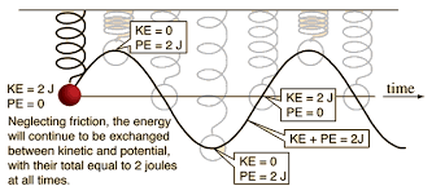Dolphins jumping during a delivery trip across the Mediterrean. Photo: Mark Roworth
|
Home >> AP Physics I >> Simple Harmonic Motion >> Mass on Spring
|
6.1 - Mass on Spring Oscillator
|
|
The YouTube clip shows a mass-spring oscillator alongside an object moving in a circle at constant angular speed. Note that the vertical position of both the objects is the same as viewed from the side. At an advanced level we can use the similarities between SHM and circular motion to accurately model oscillations.
The objectives for the AP course are:
|
Assignments 2018
A Mass on a Spring Oscillator
The energy that drives the oscillation of a spring comes from stretching the spring in the first place. We met this back in Unit 5: Work, Energy and Power as the elastic potential energy. The object at the end of the spring achieves its maximum speed when all of this potential energy has been transferred to kinetic energy. This also gives us a relationship between the stiffness of the spring (spring constant, \(k\)), the amplitude, \(x\), and the maximum speed, \(v\), of the mass.
From the principle of conservation of energy:
\[EPE_{lost} = KE_{gained}\]
\[\frac{1}{2}kx^{2}=\frac{1}{2}mv^{2}\]
\[v = \sqrt{\frac{k}{m}}x\]
\[KE_{ends}+EPE_{ends}= KE_{middle} +EPE_{middle}\]
The energy that drives the oscillation of a spring comes from stretching the spring in the first place. We met this back in Unit 5: Work, Energy and Power as the elastic potential energy. The object at the end of the spring achieves its maximum speed when all of this potential energy has been transferred to kinetic energy. This also gives us a relationship between the stiffness of the spring (spring constant, \(k\)), the amplitude, \(x\), and the maximum speed, \(v\), of the mass.
From the principle of conservation of energy:
\[EPE_{lost} = KE_{gained}\]
\[\frac{1}{2}kx^{2}=\frac{1}{2}mv^{2}\]
\[v = \sqrt{\frac{k}{m}}x\]
\[KE_{ends}+EPE_{ends}= KE_{middle} +EPE_{middle}\]
|
The energy transfers for a spring oscillator. Image from hyperphysics. This page has a simulation that enables you to change parameters and see the effect on the oscillation.
|
The period, \(T\), of an oscillator is the time taken to complete one oscillation back and forth. We will be carrying out a detailed lab on this as well as deriving the relationship from first principles. Essentially the period (and hence the frequency) are governed by a) the mass being oscillated and b) the stiffness of the spring. The frequency is the number of oscillations per second and is simply the reciprocal of the period.
\[T = 2\pi \sqrt{\frac{m}{k}}\]
Derivation is based on the circular motion concept - see animation above:
\[v = \frac{2 \pi x}{T}\]
and from the above:
\[v = \sqrt{\frac{k}{m}} x\]
substituting and rearranging yields:
\[T = 2\pi \sqrt{\frac{m}{k}}\]
\[T = 2\pi \sqrt{\frac{m}{k}}\]
Derivation is based on the circular motion concept - see animation above:
\[v = \frac{2 \pi x}{T}\]
and from the above:
\[v = \sqrt{\frac{k}{m}} x\]
substituting and rearranging yields:
\[T = 2\pi \sqrt{\frac{m}{k}}\]
